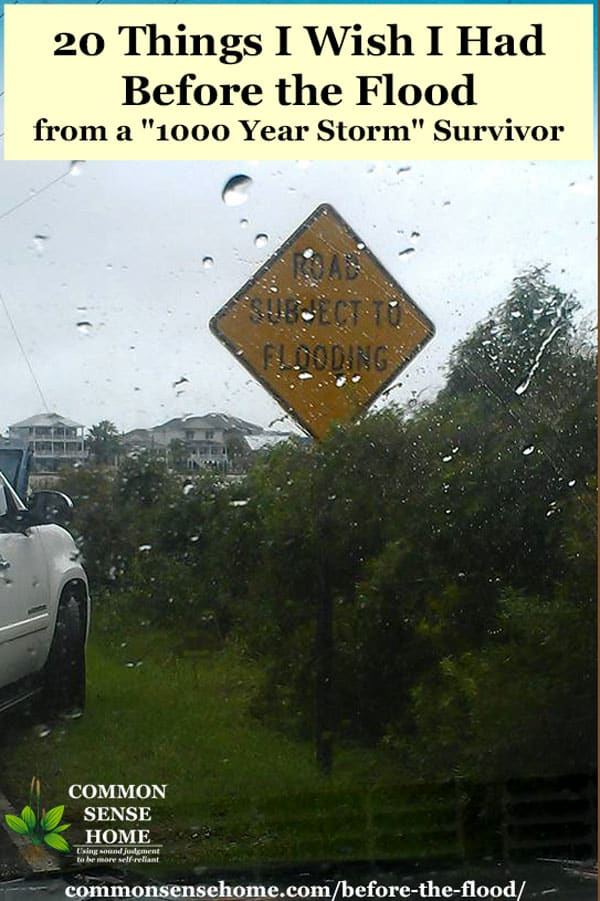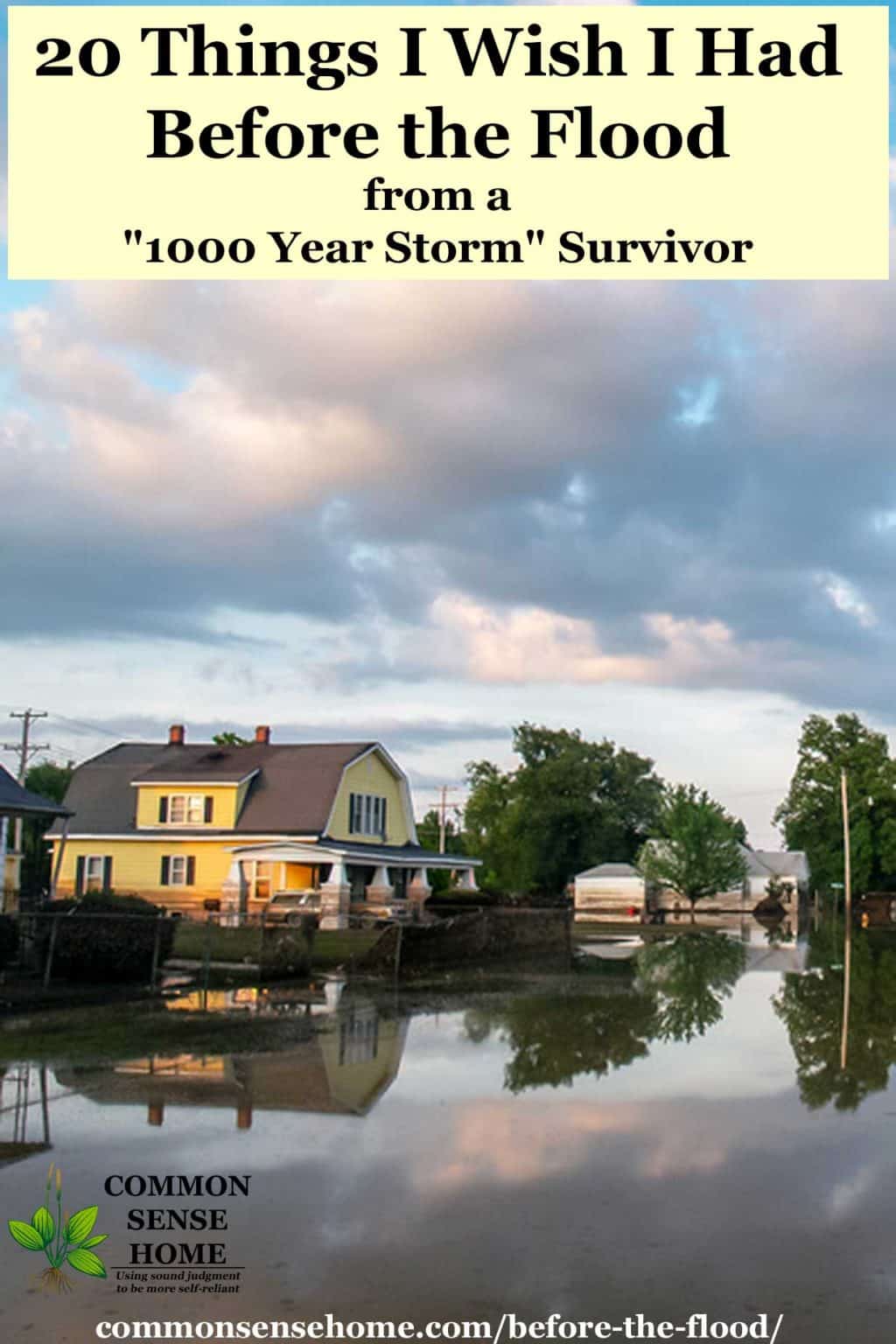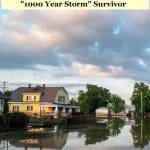20 Things I Wish I Had Before the Flood from a “1000 Year Storm” Survivor
This post may contain affiliate links. Read my full disclosure here.
Flooding from heavy rains and coastal flooding due to storm surges combined with heavy rains have been a common occurrence in recent years. In this post, I’ll share my flood experience, focusing on the flood preparedness items I didn’t realize I needed – until the storms hit. We also talk about dealing with floodwater contamination in the yard. I want to share this flood preparedness checklist with you so you can avoid the mistakes I made.

The “1000 Year Storm” – and the Flooding That Followed
The catastrophic flash flood that affected much of the Carolinas (and my home) was like nothing I’ve ever seen. I consider myself to be a prepper of sorts – always planning ahead, with a stocked pantry, medicine cabinet and survival skills. I thought I was ready for any situation, but I wasn’t ready for this. By the looks of things, neither was anyone else.
The Super Harvest Blood Moon created perfect waves for my husband (the surfer) all week, but it also created unusually high tides. The Pawleys Island law enforcement closed off the island to onlookers and tourist all week due to flooding. Homeowners could access the island at their own risk. Of course that didn’t stop the die-hard surfers (hubby included) willing to walk a mile to catch the perfect wave.
While Hurricane Joaquin is predicted to miss the U.S., it combined with low pressure area that is funneling heavy tropical moisture into the region. This has led to record breaking amounts of rain being dumped in South Carolina. Governor Nikki Haley called it “a thousand year storm” with “catastrophic flash flooding”.
Many are dead. There have been hundreds of accidents, thousands are without power and an unknown number are displaced from their homes. Half of our town is under water, roads to and from here are closed, bridges are wiped out, and people are waiting for rescue as the water levels rise. Where does that leave us? Right in the middle of it.
We live right by the ocean (exactly 4 minutes from my home to the Atlantic Ocean) on the east coast of South Carolina in a quaint town called Pawleys Island. Up until now, this has been our tropical paradise.
20 Things I Wish I Had Before the Flood
We were very blessed, but not completely unscathed. Our property damage was minor compared to many. I’ve put together this flood preparedness checklist to highlight things I didn’t think I needed, but wish I had when we were stuck in the flood zone.
Food, Water and Cooking Items (1-6)
1. Bottled water – I don’t stock bottled water for the same reason I don’t stock plastic bags – they are not environmentally friendly. But guess what? I needed them. See Emergency Water Storage and Filtration for tips on safely using flood waters.
2. Ready to eat meals. Dehydrated food, chips, snacks, dried meat, etc. As soon as I realized this thing was serious, all the roads were already closed and power outage reports where surrounding me. I did a quick inventory of our supplies and realized all of our food needed to be prepared. I was golden if we didn’t lose power, but nothing to eat if we did. (See Emergency Cooking – 10 Ways to Have a Hot Meal When the Power Goes Out)
3. Paper products – you will need disposable eating utensils, no power= no running water to wash dishes (plus the backed up septic)
4. Matches – I know this seems like a no-brainer but we didn’t have one match in the house. We had plenty of candles, and not one match.
5. Zip lock bag of fire starter. We have lots of kindling – but guess where it was when the rains hit? Yep – outside.
6. Extra propane tank. We forgot to fill ours the last time we cooked out. We could have avoided this mistake had we had an extra tank.
Health and Safety Items (7-10)
7. Battery/crank operated weather radio – the power went out and continues to go out all around us, alarms keep posting on our cell phones warning us of the eminent flooding danger. A weather radio is a must!
8. Cash stash. Even if it’s $100.00, stash some cash for emergency situations. When power is out there isn’t a way for places to run your credit card. (On the flip side, once power is up but roads are still closed, some places will accept credit cards but not cash. It’s good to have both options if possible.)
9. An old fashion paper map. With most of the roads closed and bridges wiped out, no power or cell service, a local map can save your life when evacuating. (See Maps for Preparedness)
10. Umbrellas – I normally don’t care enough about getting wet to invest in an umbrella, but when it is pouring so hard you can’t see in front of your face, an umbrella is a handy invention to have around.

Lighting and Power Items (11-13)
11. Soy or beeswax candles. We have plenty of regular candles, but nothing I would burn inside the house because of the added synthetic fragrances. The last thing I need is a migraine and my daughters’ asthma kicking in when we are dealing with an emergency situation. Having safe candles to burn inside the house is imperative.
12. Charged Solar Lights and Flashlights. I had both, several of both actually, and they were all dead. Not a lot of good in the middle of a storm. Charge emergency lighting before the flood (and power outage) and keep them handy.
Would you like to save this?
13. Extra batteries. No explanation needed. (See Best Battery Chargers and Batteries, Including Portable Battery Chargers.)
Water Removal Tools (14-15)
14. Access to shovels and hoes. 5am in the morning with lightening popping all around is not the ideal time to search through a pile of metal handle yard tools to find a shovel to cut a trench away from your home to aid in water runoff.
15. Extra garden hose. A garden hose acts as a wonderful siphon to remove excess water. We had to use one to remove water from the top of our pool and keep our cover from collapsing.
Sanitation Items (16-20)
16. Trash bags, zip lock and plastic grocery bags. Several years ago I vowed to give up plastic bags, and I did. Unfortunately for us we really needed them during this time. I was able to leave and go to a nearby store and ravage their recycle bin for several handfuls of plastic bags which saved us!
17. Extra trash can (clean and big) with a lid. During several days of rain like this, and everything is flooded, where are you going to put your trash? Not outside! Now add stinky diapers into the mix. See why you need an extra trash can (BIG) with a lid?
18. Bleach – again, going green I removed all the synthetic cleaners from my home and bleach was one of them. I will be the first to admit, there is a time and a place for everything. During an emergency situation is a time and place for bleach (and plastic).
19. Feminine products. If you have a female in the house you will need a stash of feminine products.
20. Last but not least, a portable toilet. This should have been number one (and two! Haha) but I saved the best for last. During the flooding, our septic system became flooded and we couldn’t use the sewer system. Before the flood, we had converted all of the gray water over for irrigation, so our showers and sinks were still usable. But we are not able to use our toilets for a family of 5 with three females. We immediately started to panic (the girls anyways) and quickly devised an emergency porta potty. (That pool noodle will never be the same again.) See our setup in the post, “DIY Portable Toilet, Plus Tips to Get Rid of Smells“.

What to Do About Sewage on the Lawn from Flooding
Editor’s note – Amber and I were talking about how to deal with outside contamination from sewage in the flood waters, since she has chickens and goats. From the Flooding and Sewage Back-ups: Home Care Guide of the State of Massachusetts:
The majority of the microbial population from sewage flooding onto lawns, tarmac and paved areas will be inactivated within several days due to exposure to UV radiation from sunlight. A disinfectant can be used on tarmac and paved areas. Contamination on grass could be left to degrade naturally. Typically, bacterial numbers on turf are reduced to background levels expected in the environment within 13 days, but can extend to 20 days on soil and sand in the autumn and spring. Generally, the least absorbent or pervious surfaces absorb the least sewer and bacterial concentrations and return to background levels the quickest.
We figured that the cleaning process could likely be accelerated by adding beneficial soil microbes, such as this inoculant from TeraGanix.
After the Flood
My heart and prayers go out to all of those who have lost loved-ones or have been displaced from their homes due to floods. Although I hope to never encounter this situation again, I know I will pay better attention to my prepping list for emergency situations. I hope this flood preparedness checklist helps you to spot anything that may be missing from your own flood preps.
Additional Flood Information:
You may also find other posts in our Common Sense Preparedness section useful, such as:
- When the Power Grid Fails – 10 Things You Need to Prepare
- Emergency Power Options for Your Home – Gas Generators and More
- Preparedness – Summer Storms, Tornadoes and Hurricanes

This post is by Amber Bradshaw of My Homestead Life.
Amber and her family moved from their tiny homestead by the ocean in South Carolina to forty-six acres in the Smoky Mountains in East Tennessee.
While building their off-the-grid homestead, they live like the days of old – cooking without electricity, collecting water from the creek and raising chickens, goats, pigs, turkeys, bees, and guineas. They’ve recently filmed their journey for a TV show on the Discovery Channel and the DIY Network/HGTV called Building Off The Grid: The Smokey Mountain Homestead.


No offense intended, but it actually sounds like you weren’t prepared at ALL? Despite considering yourself a prepper and survival skills haver, was there ANYTHING you had? No light, no heat, no water, no food, no toilet… wow. What a wake up call.
I think what Amber’s story illustrates is that just because you’re prepped for one type of situation, doesn’t mean you’re prepped for another. The high water levels were a game changer.
Walmart sells oil lamps for under $10. (Ours was under $8). We used that during the Ice Storm, the 1000 Year Storm, and Hurricane Matthew. Any 2 liter bottles of soda get rinsed and filled with water when finished.
Yours is a great list, but as someone who has grown up on the North Carolina coast and weathered many storms, you might want to add disposable diapers and baby formula/food for those who need them. I always make sure I have plenty of pet food, and that all necessary prescriptions are filled. I usually make sure I have bottled water on hand in case potable water isn’t available, and that my laundry is done in advance of storms. Finally, its a good idea to have a full tank of gas in all vehicles. God bless you as you recover!
I don’t think anyone knew it was going to be this bad. We didn’t lose power or have any damage other than a little bit of water in the basement and barn, but like you, there are a lot of things I wish I’d done to prepare. Like bringing extra hay down from the shed to have in the barn at the ready. At least we know for the future, although I hope we never have this much rain again.
Regarding safe candles (#15), another feature to look for is all cotton wicks. At least some candle wicks have a metal core, the burning of which releases toxic fumes.
Soy wax is not a good choice for a host of reasons—palm oil wax is far superior—details here: http://www.alohabay.com/planet/index.html.
The best source/manufacturer of palm wax candles that I know of is Aloha Bay (www.alohabay.com). They offer both unscented and scented candles, all made of palm wax. They are an outstanding example of a socially and environmentally conscientious company. An overview of this is detailed on their “About Us” page with links to additional pages of information. I have found reading through these pages to be both inspiring and educational. (Note: I have no financial ties to Aloha Bay. I just like their products and their conscientiousness.)